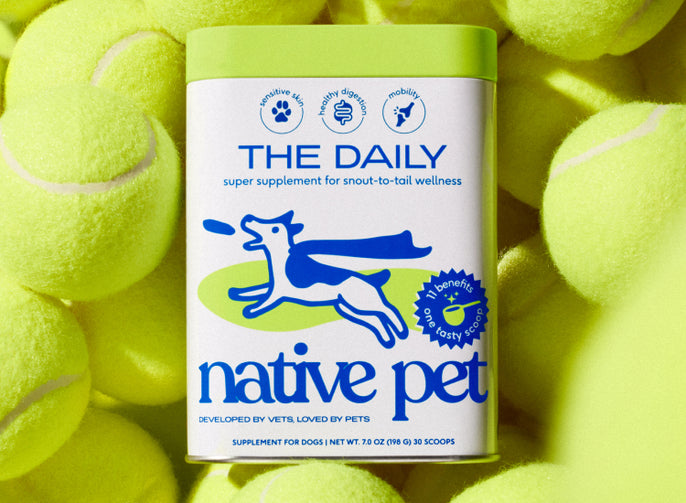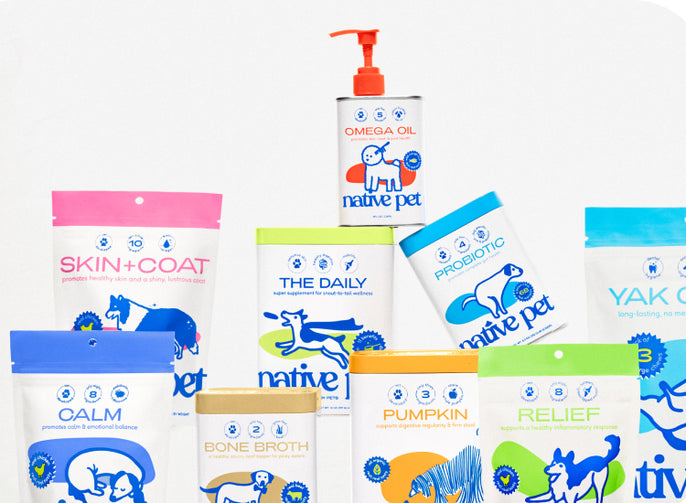Australian shepherds, or Aussies, are a beautiful dog breed. Their fluffy, medium-length coat with distinct markings has attracted many dog owners to the breed. But, can you have a dog that fluffy without a house full of fur? Do Australian shepherds shed?
Yes, the Australian shepherd sheds A LOT. We'll take a look at this dog's shedding season and cover how you can keep your house clean and care for your Aussie's coat all year round.
When Do Australian Shepherds Shed?

Aussies shed year-round with two heavy shedding seasons in the spring and fall. These two types of shedding occur because Australian shepherds have a double coat.
The Australian shepherd's coat features a dense undercoat and a slightly coarse topcoat (sometimes referred to as the outer coat). The undercoat helps keep Aussies warm in the winter and cool in the summer, while the outer coat offers year-round weather resistance. Picture yourself wearing a warm winter coat under a light, outer rain jacket — that's how the Aussie's coat works.
Because the topcoat is designed for year-round weatherproofing, it also sheds year-round. But, the topcoat sheds only lightly.
Because the undercoat is primarily needed in the winter and summer, Aussies will lose their undercoat every spring and fall. This is a heavy shedding period that's common among all dog breeds with a double coat. It's also known as blowing their coat. There will be times during this shedding period when it looks like tufts of hair are literally blowing off your dog.
How Much Do Australian Shepherds Shed?

Australian shepherds shed a lot. Many dog breeds that have a double-coat, like the Aussie's, are listed among the heaviest shedders out there. The German shepherd, husky, Labrador retriever, and golden retriever all have double coats and all frequently top the list of the heaviest shedders.
Australian shepherd shedding isn't quite as bad as other double-coated dogs, but that's like saying Dallas, Texas, isn't quite as hot as San Antonio. You're still in for a lot of heat either way.
There are many internet memes from dog owners who've collected enough of their dog's fur to make a second dog. All of these come from owners with double-coated dogs. So, before you adopt an Aussie, you need to be prepared for a lot of shedding.
But, we've got some coping mechanisms that can help you keep your house and your dog's hair in check, even in the face of heavy shedding.
How to Handle Aussie Shedding Around Your House

There are two techniques for living with a heavy shedding dog. The first is to accept dog hair as a part of your life. To a certain extent, owning a dog means living with dog hair.
Different owners have different tolerance levels for dog hair — one dog owner might be oblivious to it while another might be very unhappy about it. If you're the first type of dog owner, then you can happily invite your Aussie to sleep in your bed. If you're the second type, then you can use our second technique for dealing with dog hair: Come up with a cleaning strategy.
It is possible to keep your house clean, even with a heavy shedder like an Aussie. Try these techniques to create a less hairy situation in your home:
- Invest in a robot vacuum: A robot vacuum can run daily so the dog fur on your floors never gets out of control.
- Run your regular vacuum more often: Doing a thorough vacuuming of your floors and upholstery once a week can also make a big difference.
- Stock up on lint rollers. Keep these by your door or in your car so you can quickly remove dog fur from your clothes when you're heading out.
- Train your pet to stay off the furniture. If you give your dog their own bed and train them to use that instead of the people furniture, you can keep fur off your upholstery.
- Keep your dog out of the bedroom. This will not only keep fur out of your sheets, but it will also reduce your exposure to pet dander because you spend about one-third of your day in the bedroom and that time will be dander-free.
- Rethink your flooring. If you want to reduce the fur and dander hiding around your house, choose a hard floor, like wood or tile, because they'll be easier to clean. If, on the other hand, you just don't want to see the fur, choose a carpet that's the same shade as your dog's coat.
These are the best techniques to handle dog hair if you're trying to keep your home clean. However, if someone in your home has allergies, then it's better to accept that an Aussie might not be the best dog for you.
Instead, look for a low-shedding dog. While there are no completely hypoallergenic dogs, a no or low shedding dog will lead to less dog hair (and therefore less dander and fewer allergens) floating around your house.
Our top non-shedding breeds for allergy sufferers who love Aussies are the Lagotto Romagnolo, soft-coated wheaten terrier, or one of the many types of poodles. Like the Aussie, these are all intelligent and active medium-sized dogs.
How to Keep Your Aussie's Coat Healthy

The Australian shepherd's coat is relatively low maintenance, but taking a few steps to care for it can help reduce shedding and keep your Aussie looking healthy and smooth.
Brush Their Hair Once a Week With a Slicker Brush
This helps spread their natural oils throughout their coat, reducing dry skin and eliminating tangles and matting.
Use an Undercoat Rake During Shedding Season
This tool removes the dead hair from the undercoat, allowing you to collect their hair during their excess shedding season. Then you can throw it away so you don't find it floating around your house.
Bathe Your Dog 1-2 Times a Month
Regular grooming is good, constant grooming is bad. Try not to bathe your Aussie more than 1-2 times per month because you'll risk removing the natural oils from their coat. Use a deshedding dog shampoo to add vitamin E and fatty acids into their coat to help reduce excess shedding.
Add a Fish Oil Supplement to Their Diet
A few pumps of a fish oil on top of your dog's food can add more omega-three fatty acids into their diet and help reduce shedding. It also promotes a healthy shine and may help prevent other health problems like joint pain and arthritis.
Aussies Are Awesome (But They Definitely Shed)

The Australian shepherd is an intelligent working dog and makes a great companion for active dog lovers. But this dog breed does shed. A lot. So, in addition to all the exercise you'll get playing with your Aussie, this breed will also keep you active with a little extra vacuuming.
New technology, like robot vacuums, and a little training to keep your pet off the couch can help keep your house clean. And you can keep your pet's coat healthy and minimize shedding with regularly brushing and an omega-rich fish oil supplement.
Still, the Aussie is not a good choice for neatniks or allergy sufferers. Those dog lovers would be better off with a no- or low-shedding dog breed.
For more information about dog breeds, behavior, health, and wellness, check out the Native Pet blog.


